Guitar Cam Fun
Please don’t tell my wife how many little HD cameras I have. She wouldn’t be mad, but she would certainly tease me without mercy. These things have gotten so inexpensive that each one seemed like a reasonable purchase, it’s only when I look at all of them spread out on a table that I realize what I’ve done.
Now that I’ve done it, though, I’m pondering uses for all these gadgets. One that I’ve been playing with for a while is a “guitar cam” – a camera mounted directly on the guitar and giving an unusual view of the performance. With all these cams hanging around and Lynnie out of town I went to work.
The choice of guitar was pretty easy. The Epiphones have scattered, so the sacrificial guitar around the house these days is stage guitar #1, the Composite Acoustics OX. It’s really ideal for this project because my main tool is double stick tape, and the “raw” finish of the makes it unlikely to suffer damage.
Past Experiments
I’ve already tried out various mounting techniques for a peghead cam. I’ve used my smallest Gorillapod, but that proved too shakey. A mount that vibrates makes for a sea-sick viewing experience. One of my favorite engineering materials is packing foam of various kinds, but once again these efforts were lacking in stability, especially when I mounted the largish Zoom Q3HD on the peghead. I wound up with a stick of wood, a 1/4-20 bolt, some plastic, and lots of double stick tape, and came up with this.
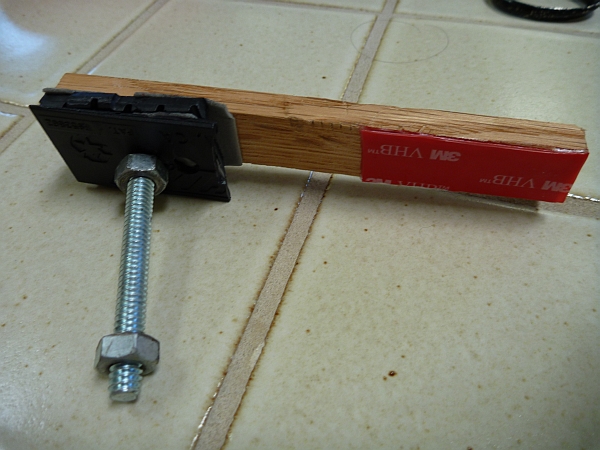
Double stick tape, a 1/4-20 bolt, and a piece of wood
Success At Last
This mount was stable and gave a good view of the guitar neck. Here it is mounted.
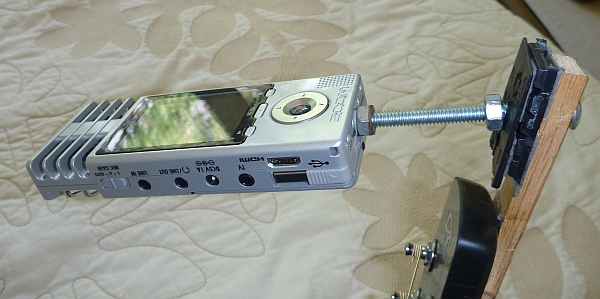
Double stick tape attaches the device to the guitar
Adjustability could be better, but it works. Heavy duty (gray) 3M double stick tape holds a stack of plastic chunks together, guiding the 1/4-20 bolt at an angle to the stick. Then lighter duty (clear) 3M double stick tape holds the stick to the back of the guitar peghead.
But We Have More Cameras
Once I had a couple of decent test shots from the peghead mounted Q3HD, I started thinking about mounting additional cameras. First, one looking straight up from the bottom of the guitar, to get the fingers plucking, and my beautiful face!! Well, that didn’t work so well. The plucking was out of focus and at he wrong angle, and my face just isn’t that lovely, or interesting.
OK, let’s put one on the front, looking at the picking hand alone. Hey, and the Kodak Zi8 has a macro setting that I almost never use. Now all we need is one looking at the fretting hand from my view. The small and light Creative Vado 2nd Gen (or third, or however many) looks like a good candidate. Sure enough these cams were easy to mount with just a bit of clear double stick tape.
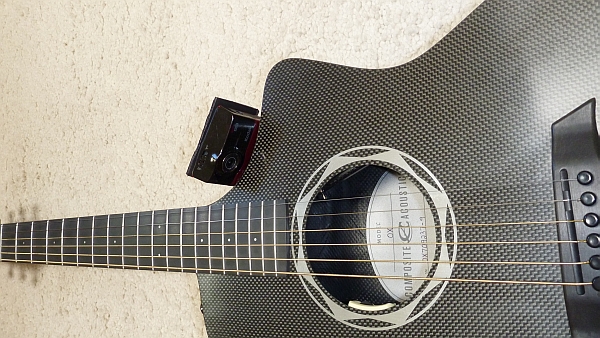
Kodak Zi8 mounted in the cutaway of the CA OX Raw
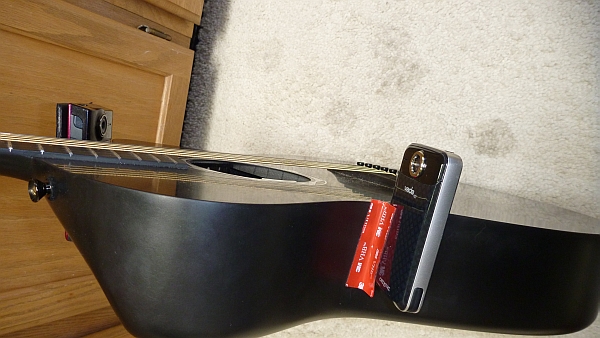
3M double stick tape holds the Vado easily
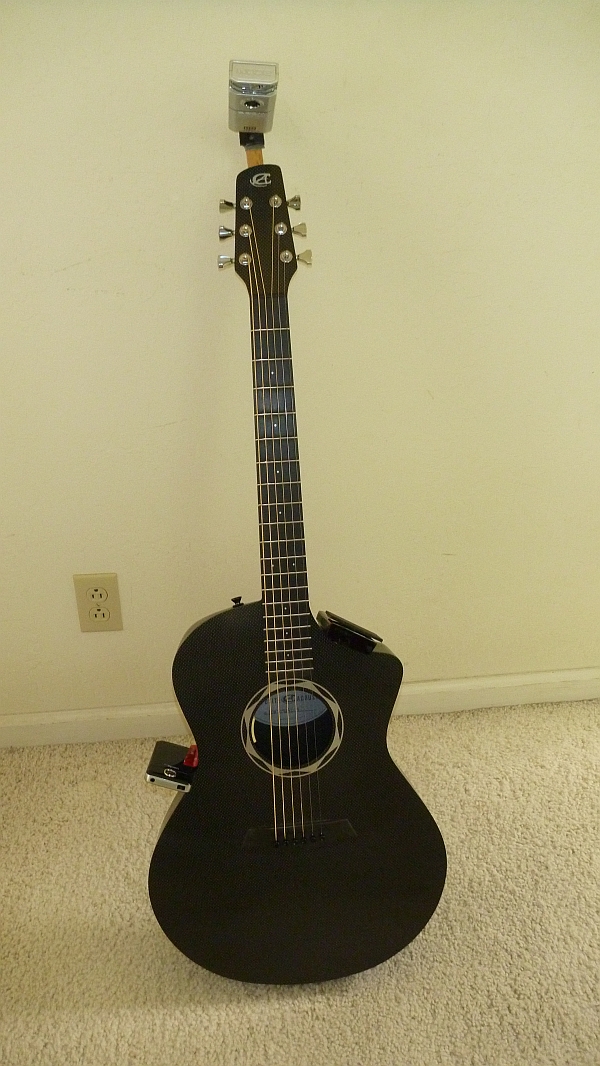
Three video cams mounted on CA OX
Lights, Cameras, Action
With the cameras mounted I scouted a location. With my sweetie out of town for a few days I had the whole house for my stage, and I found just the spot. Ordinarily I would never try to record in the close in space of a bathroom or shower, due to the strong early reflections. But for a guitar cam shoot I needed simple uncluttered monotone on both sides and this little hallway was perfect.
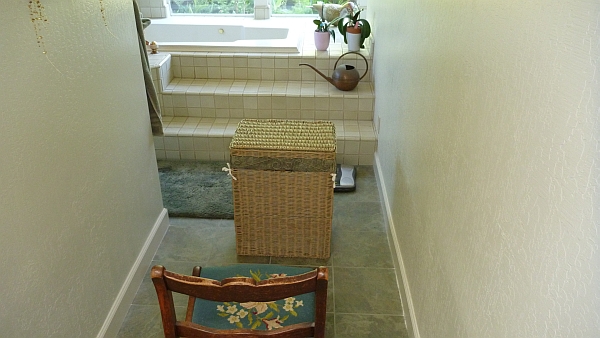
This little hallway provides two simple backgrounds
The back light would make it tough to get good video shooting down this hall, but the guitar cam(s) will be viewing side to side so they won’t get splashed. The Zoom H2 was nicely positioned by putting it on top of the hamper, and we were ready to shoot.
I barely had room for the guitar in this narrow space, but I was pretty happy with the shots I got. I spent a while shooting in another location, but when I looked at clips these were the winners.
Out of Rotation
When I pulled the clips into Edius Neo 2.5, my video editing software, I was dismayed to find that I didn’t have a way to rotate the clips. With the cameras mounted the easy way the resulting image has the guitar laying on its back, parallel to the floor.
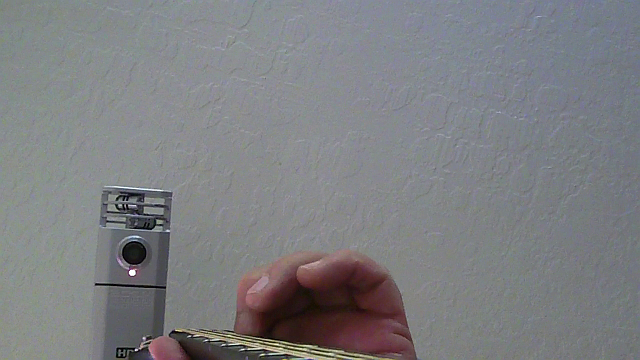
The guitar is laying down on the job
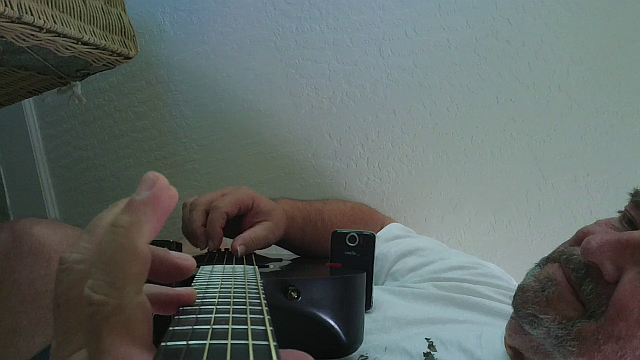
Guitar still laying down on the job
I had expected to pull these into my Edius software, rotate them, crop and resize them, and build my composition with these images showing the guitar in a normal orientation. But it turns out that my Neo 2.5 version, the previous version entry level package, doesn’t have this capability. I would have to upgrade to the full commercial package to be able to rotate these clips. Time to rethink.
My first effort was a new layout for the clip, using the odd orientation for its impact. I cut a rough version but wasn’t too impressed. Next, do it the right way, change the camera orientation with a new mounting system. That took a day and wound up too awkward and shaky. Without re-engineering the whole project I needed to work with the clips I had.
Avidemux to the Rescue
I’ve done tutorials on Avidemux in the past, it’s a powerful bit of free software that continues to grow in its ability to manipulate video. The latest versions handle these H.264 based file formats easily and with a bit of tweaking and fiddling I was able to create rotated versions of my clips with minimal loss of quality.
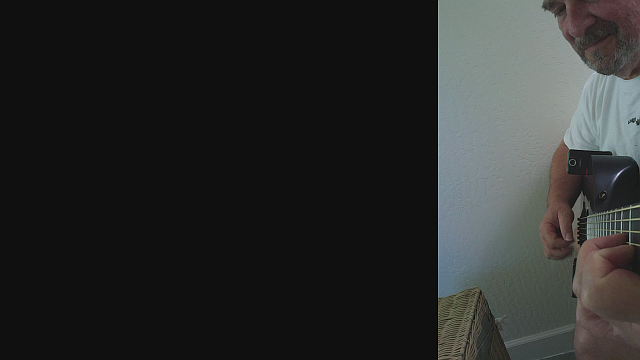
Clip from Q3HD rotated in Avidemux
In order to create a standard 720P HD video file (1280×720) that Edius would accept I first rotated the image, giving a 720×1280 layout. I resized that to 405×720 in order to create the proper vertical dimension. Then I filled out the frame to 1280 pixels wide with black as you see in the still (this image is reduced to 680×360, half size).
And Here’s the Result
The song I chose is a sprightly version of an old Hawaiian royalty piece, Moani Ke `Ala, written by Prince William Pitt Leleiohoku in the late 1800s. Gabby Pahinui recorded this piece, as did his son Cyril, and both were a great source of inspiration.
As I’m listening to the clip just after it was uploaded, I’m appalled at the sound quality. There’s a background noise that is far greater than any on the original clip. I’ve been disappointed in the past but this one is really annoying. I wonder if I’ll see any improvement from a later, more leisurely transcode by Google.
This entry was posted on Friday, August 5th, 2011 at 5:13 pm and is filed under Video. You can follow any responses to this entry through the RSS 2.0 feed. You can leave a response, or trackback from your own site.
mymydex said in post # 1,
on August 29th, 2011 at 6:01 am
thnk u wonderful playing and it sounds professional thnk u
Fran Guidry said in post # 2,
on August 29th, 2011 at 11:09 am
Thanks very much, glad you enjoyed it.
Fran
Terry Liberty said in post # 3,
on November 2nd, 2011 at 6:30 pm
Fran:
Marvelous playing and great job on the cameras! It’s interesting that the camera/guitar connection was so stable that the instrument appeared to be bolted to the floor while your body moved in relation to the guitar. Fun.
Thanks for posting.
Terry
Olympia, WA
Fran Guidry said in post # 4,
on November 4th, 2011 at 12:34 pm
Hey, Terry, that shift in perspective really does play tricks with the mind-eye, doesn’t it?
Thanks for stopping by,
Fran
Jørgen Jørgensen said in post # 5,
on January 4th, 2012 at 2:13 am
You have a new fan – I got here via the video and music syncing in reaper and I am most impressed.
How would somebody find the time….
Happy new Year!
Fran Guidry said in post # 6,
on January 4th, 2012 at 3:25 pm
Jorgen, the secret is to be an old retired guy. After putting in my time I get to play with guitars and cameras and computers all day long. It’s great!
Fran